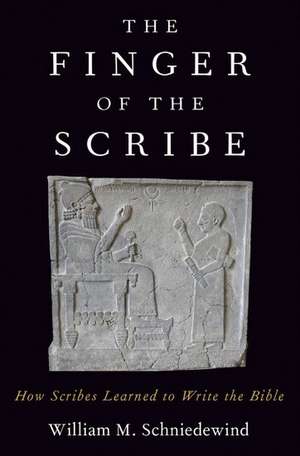The Finger of the Scribe: How Scribes Learned to Write the Bible
Autor William M. Schniedewinden Limba Engleză Hardback – 28 noi 2019
Preț: 241.46 lei
Nou
Puncte Express: 362
Preț estimativ în valută:
46.21€ • 48.06$ • 38.15£
46.21€ • 48.06$ • 38.15£
Carte disponibilă
Livrare economică 13-19 martie
Preluare comenzi: 021 569.72.76
Specificații
ISBN-13: 9780190052461
ISBN-10: 0190052465
Pagini: 248
Dimensiuni: 157 x 236 x 23 mm
Greutate: 0.5 kg
Editura: Oxford University Press
Colecția OUP USA
Locul publicării:New York, United States
ISBN-10: 0190052465
Pagini: 248
Dimensiuni: 157 x 236 x 23 mm
Greutate: 0.5 kg
Editura: Oxford University Press
Colecția OUP USA
Locul publicării:New York, United States
Recenzii
this book provides a sensible picture of how the early Israelite alphabetic scribal curriculum emerged under the influence of cuneiform tradition
Scribes and scribalism are moving to the forefront of our understanding of the literary heritage of ancient Israel, and Schniedewind's is an important voice in that discussion.
Throughout the book...he delights his readers with new insights and interpretations of his own.
Schniedewind presents an intriguing and well-documented case. The book offers a helpful corrective for those who maintain a late date for the biblical material due to a supposed lack of literacy in an early period.
Overall, The Finger of the Scribe is a helpful development in how we understand ancient Israelite scribal curriculum and its origin...a valuable contribution to the history of ancient Israel, a necessary starting point for any scholar interested in ancient Israelite scribalism.
The Finger of the Scribe is an exciting, original proposal about how ancient ancient Israelite scribes learned their craft. Schniedewind argues that a number of well-known inscriptions actually represent different stages of training in Hebrew literacy. Moreover, he presents a persuasive case that Hebrew and earlier forms of alphabetic education were modeled on educational patterns developed in Mesopotamia and practiced in Canaan up through the Late Bronze Age.
Bill Schniedewind brilliantly lays out the evidence of early Israelite scribal literacy in this clearly-written book. Basing his research in the archaeological record, Schniedewind gives the reader a glimpse of the ancient Israelite educational system: how Hebrew scribes were trained, the Mesopotamian and cuneiform pedigrees of these training methods, and how these shaped the Bible we have today. This book is essential for those studying the origins of the Bible.
It has been increasingly evident to specialists that Mesopotamian literature cannot be understood properly without grasping the realities of scribal practice, including education. With his bold proposal that the inscriptions from Kuntillet 'Ajrud reflect the work of students and show the influence of older cuneiform education, Schniedewind advances dramatically the application of this approach to alphabetic writing and biblical literature. As discussion and debate continue, this will be essential reading for years to come.
Scribes and scribalism are moving to the forefront of our understanding of the literary heritage of ancient Israel, and Schniedewind's is an important voice in that discussion.
Throughout the book...he delights his readers with new insights and interpretations of his own.
Schniedewind presents an intriguing and well-documented case. The book offers a helpful corrective for those who maintain a late date for the biblical material due to a supposed lack of literacy in an early period.
Overall, The Finger of the Scribe is a helpful development in how we understand ancient Israelite scribal curriculum and its origin...a valuable contribution to the history of ancient Israel, a necessary starting point for any scholar interested in ancient Israelite scribalism.
The Finger of the Scribe is an exciting, original proposal about how ancient ancient Israelite scribes learned their craft. Schniedewind argues that a number of well-known inscriptions actually represent different stages of training in Hebrew literacy. Moreover, he presents a persuasive case that Hebrew and earlier forms of alphabetic education were modeled on educational patterns developed in Mesopotamia and practiced in Canaan up through the Late Bronze Age.
Bill Schniedewind brilliantly lays out the evidence of early Israelite scribal literacy in this clearly-written book. Basing his research in the archaeological record, Schniedewind gives the reader a glimpse of the ancient Israelite educational system: how Hebrew scribes were trained, the Mesopotamian and cuneiform pedigrees of these training methods, and how these shaped the Bible we have today. This book is essential for those studying the origins of the Bible.
It has been increasingly evident to specialists that Mesopotamian literature cannot be understood properly without grasping the realities of scribal practice, including education. With his bold proposal that the inscriptions from Kuntillet 'Ajrud reflect the work of students and show the influence of older cuneiform education, Schniedewind advances dramatically the application of this approach to alphabetic writing and biblical literature. As discussion and debate continue, this will be essential reading for years to come.
Notă biografică
William M. Schniedewind has been a Professor of Biblical Studies and Northwest Semitic Languages at UCLA for twenty-five years. He has been the Chair of the Department of Near Eastern Languages and Cultures and held the Kershaw Endowed Chair of Ancient Eastern Mediterranean Studies. Professor Schniedewind is the author of six books and numerous articles.
